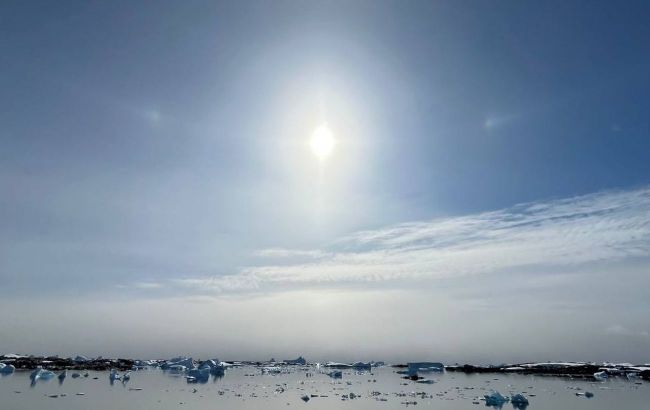'Ring of three suns': Ukrainian polar explorers capture stunning rare sky phenomenon on video
 Ukrainian polar explorers shared footage of "three suns" in the sky (photo: t.me/vernadsky_antarctica)
Ukrainian polar explorers shared footage of "three suns" in the sky (photo: t.me/vernadsky_antarctica)
Ukrainian polar explorers shared footage of an incredible optical phenomenon. The "ring with three suns" effect was captured near the Akademik Vernadsky station, according to the National Antarctic Scientific Center (NANC) press service.
What exactly Ukrainian polar explorers captured on camera
Recently, Ukrainian polar explorers near the Akademik Vernadsky station managed to film an interesting optical effect—two parhelia, or mock suns.
These are small bright spots located on either side of the real sun, at the same horizontal level.

Two parhelia on either side of the real sun (photo: t.me/vernadsky_antarctica)
In the video taken by Serhii Yakushchenko, a member of the current UAE (30th Ukrainian Antarctic Expedition), you can also see a complete parhelic circle—a line that passes through the sun, the parhelia, and across the sky parallel to the horizon.
"It looks like a ring with gems lying in the sky," the NANC publication notes.
Previously, the polar team observed a 22-degree solar halo around the sun, but it disappeared quickly and wasn’t captured on video.
When multiple suns or other halo effects can be seen in the sky
According to experts, all these effects belong to the halo family—an optical phenomenon in the atmosphere that appears as "secondary illumination."
It occurs due to the refraction and reflection of sunlight in ice crystals, which are usually:
- found in cirrus or cirrostratus clouds, or
- suspended lower in cold, moist air as diamond dust.
Depending on the shape of the crystals and the paths of the light rays, different types of halos can form.
The most commonly observed halo is the circular halo around a light source, such as the sun, moon, or even street lamps. Less commonly seen are:
- parhelia (sun dogs)
- paraselenae (moon dogs)
- zenith arcs
- light pillars
"But a complete parhelic circle is a unique phenomenon, as it has a complex formation mechanism," specialists emphasized.
It involves light rays reflecting off the outer surface of the crystal and being refracted multiple times—up to five times—inside the crystal.
Different reflection mechanisms are responsible for forming different parts of the parhelic circle.
"Another interesting fact: circular halos and parhelia are mostly located 22 degrees from the sun," NANC experts pointed out.
They also explained why this occurs.
"Under standard conditions, the crystals have a hexagonal shape. Each crystal acts like a prism: the ray enters through one face and exits through another, refracting precisely at 22 degrees," the experts explained.
When the crystals are thick and plate-like, the initial parhelia can create the next ones at 44 degrees (they are very rare too).
"Rays of light and ice crystals draw such unusual scenes in the sky. Of course, most types of halos are observed in polar regions, but they can also be seen at other latitudes," the NANC concluded.

